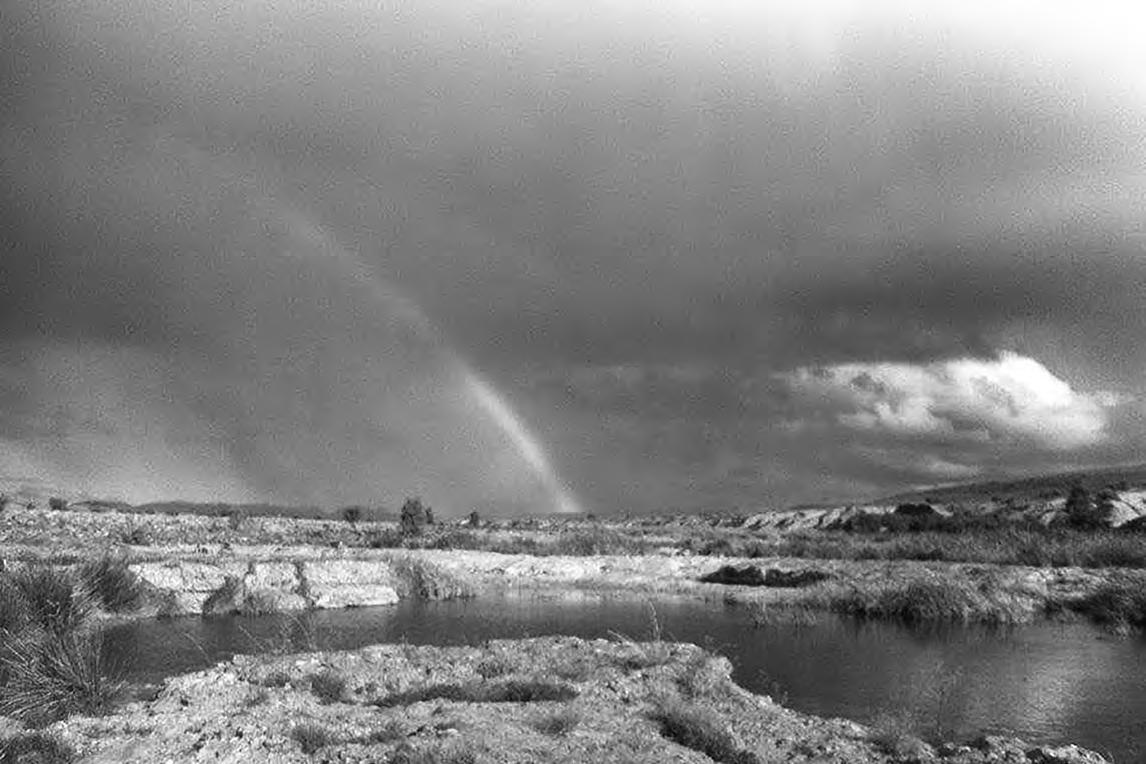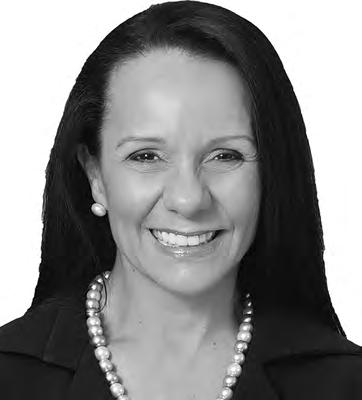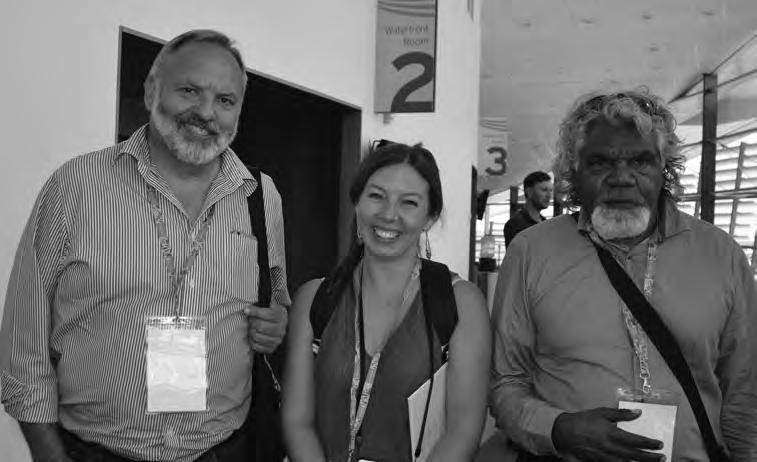
9 minute read
Inside: APY Land Rights Act changes
Federal nuclear waste site proposed for Wallerberdina Station in the Flinders Ranges
Traditional owners have expressed shock at news that the Federal Government is likely to place a nuclear waste dump in the Flinders Ranges neighbouring Yappala Station.
Advertisement
In April, the Federal Government announced that a site near Barnidoota in the Flinders Ranges is the most likely site for a low level nuclear waste storage site. The Federal Government is considering the purchase of 100 hectares of Wallerberdina Station for the storage of low-level and intermediate radioactive waste created by Australian hospitals and industry. The site neighbours Yappala Station, which was granted to the Viliwarina Yura Corporation in 2000.
The Federal Government’s proposal is separate to current proposals by the State Government to build a dump for high and intermediate level international waste.
The announcement by Federal Resources Minister, Josh Frydenburg, followed a process where six sites around Australia were shortlisted after being nominated by their owners. Barnidoota Station is held under perpetual lease by Former Liberal Senator Grant Chapman. Minister Frydenburg said that Mr Chapman played no part in making the decision and stood to gain very little from the placement of the dump.
The Federal Minister said that Barndioota was chosen because of geological settings, technical capability and access to transport.
Further tests would be conducted before the site would be confirmed.
When the announcement was made, Adnyamathanha woman Regina McKenzie
Above: Hookina Waterhole. Photo: Kerwin Stuart.
told the ABC that her community was shattered by the announcement.
“It was shock and then a lot of emotion, myself and my sister said it’s like getting news of a death, that’s the kind of emotion we felt,” she said.
“Our culture in that area is being ignored, it’s not good for our area, I don’t think. It’s something we will fight against, we don’t want a waste dump in our area whatsoever.”
When the site was first suggested, she said that the dump could destroy significant cultural heritage and countless sacred sites around a permanent spring – Hookina Creek. The Adnyamathanha people are also worried about the risk from large floods known to hit the area, and Andyamathanya elder Eunice Marsh, told the ABC that she feared the loss of her people’s heritage in the region, if rising flood waters mixed with radioactive waste.
“If we’re going to have that poison stuff here, even if it’s a low-level situation, it’s just absolute madness to put something like this near somewhere that’s so special,” she said.
“It’s everything; it’s a type of importance that you would never be able to describe. The connection to this land for Adnyamathanha people is their culture, their customs; it’s their identity.” “If we’re going to have that poison stuff here, even if it’s a low-level situation, it’s just absolute madness to put something like this near somewhere that’s so special…”
If the site is selected, local residents will be given 12 months to negotiate a community package, with up to $2 million expected to be made available by the Federal Government for local projects.
Key changes to APY Land Rights Act passed
Legislation to change the Anangu Pitjantjatjara Yankunytjatjara Land Rights Act 1981 (SA) is currently before Parliament (House of Assembly) and is likely to pass in late September when Parliament next sits.
In 2013, the previous Minister for Aboriginal Affairs and Reconciliation, the Honourable Ian Hunter MLC, commissioned an independent limited review of the Anangu Pitjantjatjara Yankunytjatjara Land Rights Act 1981.
Following the review and various consultation processes from 2013–2016, the APY Land Rights (Miscellaneous) Amendment Bill 2016 (SA) was introduced into Parliament on 22 June 2016 and was passed by the Legislative Council on 4 August 2016. The amendments contained in the Bill change some key areas of APY governance. These include:
• establishing 7 electorates across APY lands and an electoral roll
• providing for gender balance on a 14 member APY Executive Board
• establishing eligibility criteria for APY statutory officers and APY Executive
Board members
• providing greater certainty for election dates, with elections held between 1 May and 31 August every 3 years
• removing voting by marbles and enable absentee voting. The Minister for Aboriginal Affairs and Reconciliation, Hon. Kyam Maher told Aboriginal Way that the changes were not an overhaul of the Act but a way to ensure that Act remains relevant. “The most significant change is to the Board and the way people are elected. The Board now has 14 member across that APY lands with both a male and female representatives.”
The Anangu Land Paper Tracker Project has been following the process of the Bill and feels that the Bill was not properly consulted with the Anangu community.
“The Anangu Lands Paper Tracker remains very concerned that key changes to the Land Rights Act were pushed through without proper consultation with Anangu Tjuta and Traditional Owners.” The Paper Tracker states that the Bill introduced to Parliament did not reflect community responses. “The Final version of the Bill that was introduced into Parliament looks different to the one that was discussed during the consultations. This final version of the Bill has not been taken back to communities and their organisations for their final consideration and approval. Communities were not aware of the changes that had been made to the Bill.”
The Minister said the consultation process was sufficient and that there was now a need to act on those recommended changes.
“The criticism on the consultation process I think is an unfair one. A panel lead by the Honourable Robyn Layton visited the APY lands eight times and held 24 separate meetings. There has been ample consultation with Anangu and other stakeholders over the past three years and the last lot of comments we were seeing coming through was that the changes recommended should be put in place,” said the Minister.
Recognition a priority for Australia’s first Indigenous woman in the House of Representatives
As the first Indigenous woman to be elected to the Federal House of Representatives, Linda Burney has said that changing the Australian Constitution to recognise Aboriginal and Torres Strait Islander Peoples is a priority.
Ms Burney was elected to the seat of Barton in NSW at the recent Federal election. Ms Burney brings with her over a decade in politics and a career in teaching, having just stepped down as Deputy Leader of the Opposition for NSW in March, to run for the seat. Ms Burney told ABC Radio that while seeing Aboriginal people officially recognised as part of the Australian Constitution is a top priority for her this term, she believed that it needed to be timed correctly. “We put this referendum when we know it will succeed. It is more important that it succeeds than it lines up symbolically with that date,” she said. 2017 marks the 50th anniversary of the 1967 Referendum that saw amendments to the Australian Constitution, allowing Aboriginal people to be counted in the census and changed the way laws were made for them federally.

Above: Linda Burney.
Ms Burney will be one of three Aboriginal people in the Labor caucus, which will also include WA Senator Pat Dodson and NT Senator-elect Malarndirri McCarthy.
Lake Torrens Native Title Applications Dismissed
On 9 August 2016 the Federal Court of Australia dismissed three overlapping applications for native title over the lands and waters of Lake Torrens.
Applications for determinations of native title had been made by the Kokatha, Adnyamathanha and the Barngarla people. Justice Mansfield in his final judgment in South Australia was “not persuaded that a determination of native title in favour of any of the three applicants should be made in respect of any part of the claim area.”
Antakaringa Matu Yankunytjatjara Aboriginal Corporation making moves in the business world
Since achieving native title five years ago, Antakaringa Matu Yankunytjatjara Aboriginal Corporation (AMYAC) has made headway with successful business ventures and a plan for future growth.
Ian Crombie, AMYAC Board member, has been there from the beginning. “We’ve come a long way since our native title claim was filed in 1995. We received native title in 2011 and now we’ve hit the ground running with our business ventures.
“We have a solid plan and our primary focus is economic growth into the future. The mining royalties won’t last forever so we are making sure we have assets and businesses in place for our people to thrive, to be educated, employed and empowered,” he said.
AMYAC represents the Antakirinja MatuYankunytjatjara Native Title holders in relation to a large area of land far north of South Australia, around Coober Pedy. At the 2011 Consent Determination, Mr Crombie spoke about the Antakirinja Matu-Yankunytjatjara people having a strong relationship with the mining companies in the region and he was looking forward to the opportunities native title will bring. “We see education, training and jobs for our children and grand-children as the way for the future.” Five years on, Mr Crombie is speaking with enthusiasm and clarity about the goals and achievements of AMYAC. “Last year we got our first contract in our own right. We have a contract between Oz Minerals and our new business enterprise, AMY Environmental Services. We provide a waste management service for Oz Minerals at Prominent Hill and look after their drink vendors, as well as other jobs. This means we have extra employment and a cash flow. Now that we have started, we plan to grow the business,” said Mr Crombie.
For the purpose of pursuing commercial entities and economic development, AMYAC engaged independent consultants to provide advice to the Board of Directors.
AMYAC formed a new Board called AMY Nominees to be solely responsible for commercial business ventures.
In 2014, Dean Liebelt was appointed as a member of the AMYAC Nominees Board and as their Business Development Manager. AMYAC commissioned a consultant to prepare an Economic Development Plan for the corporation and Dean is responsible for pursing economic opportunities. Mr Liebelt said he is extremely busy with AMYAC this year and has lots on the horizon for the corporation.
“Since December last year, it has really started to get busy and we have been looking at new business ventures and sustainable economic ideas.
“We are doing a lot of good things and I think it is because of the people we have and the way we work together that is allowing us to get things done and not miss opportunities,” he said.
Mr Liebelt, who has experience working with Aboriginal Corporations over the years, is excited to see where AMYAC is going. “AMYAC is a great example of what native title corporations can do, and I hope we


Above top: Ian Crombie. Above bottom: Keith Thomas, Kaliah Tsakalidis and Ian Crombie.
can see more success stories in the future,” he said. AMYAC’s achievements were acknowledged this year with a Premier’s award for Indigenous Social Inclusion. The corporation jointly won the award with OZ Minerals for establishing a partnership and “laying the foundation to leverage long term business opportunities beyond the life of the Prominent Hill mine and outside of the resource industry,” Premier’s Community Excellence Awards.
Mr Liebelt said “the award was a big deal for us. The thing to mention here is that AMYAC is doing it all themselves. We are independent of government and tax payer dollars and we are dynamic because of that.
It’s going to be a good year for AMYAC, we are looking at other contracts at the moment and this will lead to bigger things,” he said.




